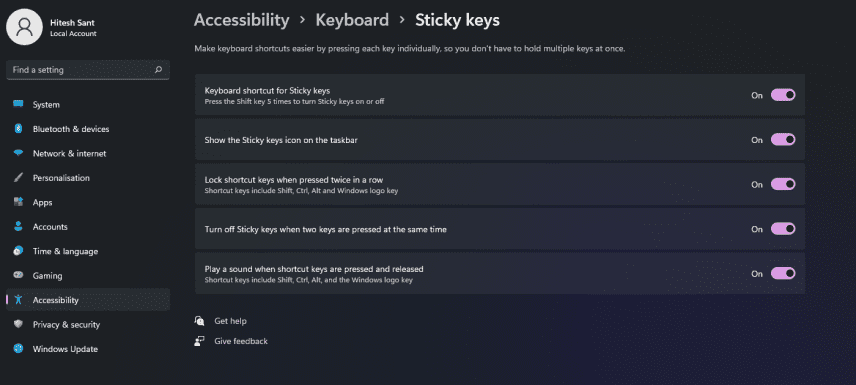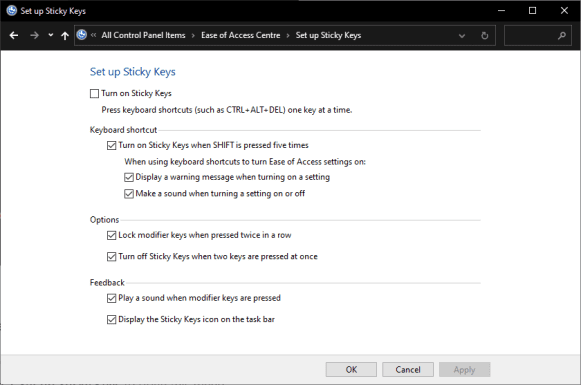The Complete Guide to Sticky Keys in Windows 10/11 [2023]
This is not only about how to turn Sticky Keys on and off, but also a useful guide on how to use them to make some tasks easier on a Windows PC. Keep for updates.
Working on a Windows PC is nothing short of a treasure hunt. There are many features hidden in plain sight that I never thought of.
Although an experienced Windows user can find many utilities, even the average user has a lot to learn.
One such feature to look out for is Sticky Keys. If you're a Windows user, chances are you've come across this prompt at least once:
I've seen this quite a few times only to embarrassingly close it - without even trying to figure out what it's about?
What are sticky keys?
Sticky Keys allows you to use the modifier keys (Ctrl, Shift, Alt, and ⊞) without having to constantly press them.
For example, they can help you select everything, copy and paste by pressing A, C and V instead of using Ctrl+A, Ctrl+C and Ctrl+V.
In short, they make a certain modifier key "sticky" until you turn them off. In addition, you can use keyboard shortcuts such as Ctrl+Alt+Delete, one keystroke at a time.
And it's very easy to turn them on and off, and you don't have to open the control panel every time or even once if you're good at some keyboard shortcuts.
We will see…
How to turn on sticky keys?
There are various ways to enable Sticky Keys. We will see all possible ways in Windows 10 and 11.
Pressing Shift
This method is exactly the same for Windows 10 and 11.
The easiest way to enable this feature is to press the Shift key five times in a row. Subsequently, you will see the prompt "Do you want to turn on Sticky Keys?" (as shown in the previous image) followed by a beep.
Click Yes to continue.
There is this notification on the taskbar, indicating which sticky keys are active. However, sometimes it can hide inside the taskbar notification area, marked with the symbol ⬆️next to other indicators.
Windows Settings
This is slightly different depending on which version of Windows you have, so we'll see both.
Windows 10
Go to Settings > Accessibility > Keyboard > Sticky Keys.

However, you can directly search for Sticky Keys in the taskbar and click on the corresponding option to get to this area.
Windows 11
Here you need to find Settings > Accessibility > Keyboard > Sticky Keys.

All options are identical to Windows 10 and work the same way.
Control Panel
Turning on Sticky Keys from Control Panel is very easy and the steps are identical for both versions of Windows.
Hence, we will continue with Windows 10.
Go to Control Panel > All Control Panel Items > Ease of Access Center > Make the Keyboard Easier to Use > Customize Sticky Keys to open this menu:

Here you can customize everything related to Sticky Keys to your liking.
Quick Settings (Windows 11)
This method is exclusive to Windows 11.
Start by pressing ⊞ + A.
Click "Accessibility" in the pop-up window.
Turn on the Sticky key switch located at the bottom.
Check this:
So these were some ways to enable this feature. Let's continue with…
How to use sticky keys?
Although the settings are quite simple, I will try to explain them to make it even easier.
We have already seen how to enable them. Notably, pressing Shift five times is the easiest way, unless you want to change some settings.
But we will continue without changing anything in the Control Panel.
Let's take the usual select-copy-paste example, assuming Sticky Keys is enabled.
You will press Ctrl (modifier key) twice to lock it. Two consecutive beeps will confirm the selection.
This means that Ctrl is active and will remain so until we turn it off (we'll see this later).
Now all you have to do is use A, C and V to select everything, copy and paste since Ctrl is constantly "pressed".
But you may also need to select selectively ( 😀), not all content. To do this, you need to block another modifier key - Shift. Similarly, this can be done by pressing Shift twice (note the two beeps again).
Now you have Ctrl and Shift in active mode and you can use other keyboard shortcuts for selection (arrow keys) and copy-paste (C and V).
To cancel a selection, press a specific modifier key (another beep).
Or, press two modifier keys together to turn off Sticky Keys (another unique beep).
Summarize:
Modifier keysCtrl, Shift, Alt, and ⊞Turn on Sticky KeysPress Shift five timesLock modifier keyPress twice in a rowUnlock any modifier keyPress onceTurn off StickyKeypress any two modifiers at the same time
Summary
We hope that it became clear how to use Sticky Keys in Windows 10 and 11.